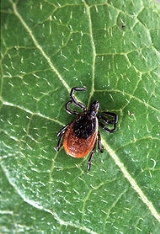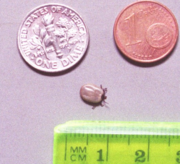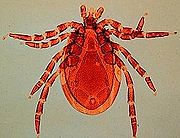
Ixodes scapularis
Encyclopedia
Ixodes scapularis is commonly known as the deer tick or blacklegged tick (although some people reserve the latter term for Ixodes pacificus
, which is found on the West Coast of the USA), and in some parts of the USA as the bear tick. It is a hard-bodied tick
(family Ixodidae
) of the eastern and northern Midwestern United States
. It is a vector for several diseases of animals, including humans (Lyme disease
, babesiosis
, anaplasmosis
, etc) and is known as the deer tick due to its habit of parasitizing the white-tailed deer
.

 The image shown at the upper right—and in fact, most images of Ixodes scapularis that are commonly available—show an adult that is unengorged, that is, an adult that has not had a blood meal. This is natural, since the ticks are generally removed immediately upon discovery to minimize the chance of disease. However, the abdomen that holds blood is so much larger when engorged and looks so different from the rest of the tick that it would be easy to assume that an engorged specimen of Ixodes scapularis is an entirely different tick (see photo at left).
The image shown at the upper right—and in fact, most images of Ixodes scapularis that are commonly available—show an adult that is unengorged, that is, an adult that has not had a blood meal. This is natural, since the ticks are generally removed immediately upon discovery to minimize the chance of disease. However, the abdomen that holds blood is so much larger when engorged and looks so different from the rest of the tick that it would be easy to assume that an engorged specimen of Ixodes scapularis is an entirely different tick (see photo at left).
When the deer tick has consumed a blood meal its abdomen will be a light grayish-blue color, whereas the tick itself is chiefly black. In identifying an engorged tick it is helpful to concentrate on the legs and upper part of the body.
Ticks are very hardy creatures and Ixodes scapularis is no exception. Expect them to be active even after a moderate to severe frost
as daytime temps can warm them enough to keep them actively searching for a host. In the spring, they can be one of the first invertebrates to become active. Deer ticks can be quite numerous and seemingly gregarious in areas where they are found.
 Ixodes scapularis is the main vector of Lyme disease
Ixodes scapularis is the main vector of Lyme disease
in North America
. It can also transmit other Borrelia species including Borrelia miyamotoi
.
Ticks that transmit Borrelia burgdorferi
to humans can also carry and transmit several other parasites such as Theileria microti
and Anaplasma phagocytophilum
, which cause the diseases babesiosis
and human granulocytic anaplasmosis
(HGA), respectively. Among early Lyme disease patients, depending on their location, 2%–12% will also have HGA and 2%–40% will have babesiosis.
Co-infections complicate Lyme symptoms, especially diagnosis and treatment. It is possible for a tick to carry and transmit one of the co-infections and not Borrelia, making diagnosis difficult and often elusive. The Centers for Disease Control (CDC)'s emerging infections diseases department did a study in rural New Jersey
of 100 ticks and found that 55% of the ticks were infected with at least one of the pathogens.
Please read to protect yourself from Deer ticks that may cause Lyme disease. http://www.mass.gov/Eeohhs2/docs/dph/cdc/factsheets/lyme.pdf
Ixodes pacificus
Ixodes pacificus, the Western blacklegged tick, is a species of Ixodes, a parasitic tick found on the western coast of North America. It is the principal vector of Lyme Disease in that region....
, which is found on the West Coast of the USA), and in some parts of the USA as the bear tick. It is a hard-bodied tick
Tick
Ticks are small arachnids in the order Ixodida, along with mites, constitute the subclass Acarina. Ticks are ectoparasites , living by hematophagy on the blood of mammals, birds, and sometimes reptiles and amphibians...
(family Ixodidae
Ixodidae
Ixodidae is a family of ticks containing the hard ticks.-Description:They are distinguished from the other main family of ticks, the soft ticks by the presence of a scutum or hard shield...
) of the eastern and northern Midwestern United States
United States
The United States of America is a federal constitutional republic comprising fifty states and a federal district...
. It is a vector for several diseases of animals, including humans (Lyme disease
Lyme disease
Lyme disease, or Lyme borreliosis, is an emerging infectious disease caused by at least three species of bacteria belonging to the genus Borrelia. Borrelia burgdorferi sensu stricto is the main cause of Lyme disease in the United States, whereas Borrelia afzelii and Borrelia garinii cause most...
, babesiosis
Babesiosis
Babesiosis is a malaria-like parasitic disease caused by infection with Babesia, a genus of protozoal piroplasms. After trypanosomes, Babesia are thought to be the second most common blood parasites of mammals and they can have a major impact on health of domestic animals in areas without severe...
, anaplasmosis
Human granulocytic anaplasmosis
Human granulocytic anaplasmosis is an infectious disease caused by Anaplasma phagocytophilum, an obligate intracellular bacterium that is typically transmitted to humans by at least three kinds of ticks, including Ixodes scapularis, Ixodes pacificus, and Dermacentor variabilis...
, etc) and is known as the deer tick due to its habit of parasitizing the white-tailed deer
White-tailed Deer
The white-tailed deer , also known as the Virginia deer or simply as the whitetail, is a medium-sized deer native to the United States , Canada, Mexico, Central America, and South America as far south as Peru...
.

Description

When the deer tick has consumed a blood meal its abdomen will be a light grayish-blue color, whereas the tick itself is chiefly black. In identifying an engorged tick it is helpful to concentrate on the legs and upper part of the body.
Behavior
Ixodes scapularis has a 2 year life cycle, during which time it passes through three stages: larva, nymph, and adult. The tick must take a blood meal at each stage before maturing to the next. Deer tick females latch onto a host and drink its blood for four to five days. After it is engorged, the tick drops off and overwinters in the leaf litter of the forest floor. The following spring, the female lays several hundred to a few thousand eggs in clusters. Transtadial (between tick stages) passage of Borrelia burgdorferi is common. Vertical passage (from mother to egg) of Borrelia is uncommon.Ticks are very hardy creatures and Ixodes scapularis is no exception. Expect them to be active even after a moderate to severe frost
Frost
Frost is the solid deposition of water vapor from saturated air. It is formed when solid surfaces are cooled to below the dew point of the adjacent air as well as below the freezing point of water. Frost crystals' size differ depending on time and water vapour available. Frost is also usually...
as daytime temps can warm them enough to keep them actively searching for a host. In the spring, they can be one of the first invertebrates to become active. Deer ticks can be quite numerous and seemingly gregarious in areas where they are found.
As disease vector

Lyme disease
Lyme disease, or Lyme borreliosis, is an emerging infectious disease caused by at least three species of bacteria belonging to the genus Borrelia. Borrelia burgdorferi sensu stricto is the main cause of Lyme disease in the United States, whereas Borrelia afzelii and Borrelia garinii cause most...
in North America
North America
North America is a continent wholly within the Northern Hemisphere and almost wholly within the Western Hemisphere. It is also considered a northern subcontinent of the Americas...
. It can also transmit other Borrelia species including Borrelia miyamotoi
Borrelia miyamotoi
Borrelia miyamotoi is a spirochete bacteria and part of the Borrelia genus. A zoonotic bacteria, B. miyamotoi can be transferred to humans through the deer tick , the same tick species that spreads B. burgdorferi, the causative agent of Lyme Disease...
.
Ticks that transmit Borrelia burgdorferi
Borrelia burgdorferi
Borrelia burgdorferi is a species of Gram negative bacteria of the spirochete class of the genus Borrelia. B. burgdorferi is predominant in North America, but also exists in Europe, and is the agent of Lyme disease....
to humans can also carry and transmit several other parasites such as Theileria microti
Theileria microti
Theileria microti is a parasitic blood-borne piroplasm transmitted by deer ticks. It was previously in the taxonomic genus Babesia, as Babesia microti, until ribosomal RNA comparisons placed it in the sister genus Theileria. T...
and Anaplasma phagocytophilum
Anaplasma phagocytophilum
Anaplasma phagocytophilum is a gram-negative bacterium that is unusual in its tropism to neutrophils...
, which cause the diseases babesiosis
Babesiosis
Babesiosis is a malaria-like parasitic disease caused by infection with Babesia, a genus of protozoal piroplasms. After trypanosomes, Babesia are thought to be the second most common blood parasites of mammals and they can have a major impact on health of domestic animals in areas without severe...
and human granulocytic anaplasmosis
Human granulocytic anaplasmosis
Human granulocytic anaplasmosis is an infectious disease caused by Anaplasma phagocytophilum, an obligate intracellular bacterium that is typically transmitted to humans by at least three kinds of ticks, including Ixodes scapularis, Ixodes pacificus, and Dermacentor variabilis...
(HGA), respectively. Among early Lyme disease patients, depending on their location, 2%–12% will also have HGA and 2%–40% will have babesiosis.
Co-infections complicate Lyme symptoms, especially diagnosis and treatment. It is possible for a tick to carry and transmit one of the co-infections and not Borrelia, making diagnosis difficult and often elusive. The Centers for Disease Control (CDC)'s emerging infections diseases department did a study in rural New Jersey
New Jersey
New Jersey is a state in the Northeastern and Middle Atlantic regions of the United States. , its population was 8,791,894. It is bordered on the north and east by the state of New York, on the southeast and south by the Atlantic Ocean, on the west by Pennsylvania and on the southwest by Delaware...
of 100 ticks and found that 55% of the ticks were infected with at least one of the pathogens.
External links
- Information on Tick-Related Health Threats and Deer Tick Fact Sheet from the National Pest Management Association
- blacklegged tick, Ixodes scapularis on the UFUniversity of FloridaThe University of Florida is an American public land-grant, sea-grant, and space-grant research university located on a campus in Gainesville, Florida. The university traces its historical origins to 1853, and has operated continuously on its present Gainesville campus since September 1906...
/ IFASInstitute of Food and Agricultural SciencesThe University of Florida’s Institute of Food and Agricultural Sciences is a federal-state-county partnership dedicated to developing knowledge in agriculture, human and natural resources, and the life sciences, and enhancing and sustaining the quality of human life by making that information...
Featured Creatures Web site - Ixodes scapularis, black-legged tick, deer tick overview as a vector for Lyme disease, developmental stages at MetaPathogen
- Ixodes scapularis genome sequence at VectorBase
Please read to protect yourself from Deer ticks that may cause Lyme disease. http://www.mass.gov/Eeohhs2/docs/dph/cdc/factsheets/lyme.pdf

